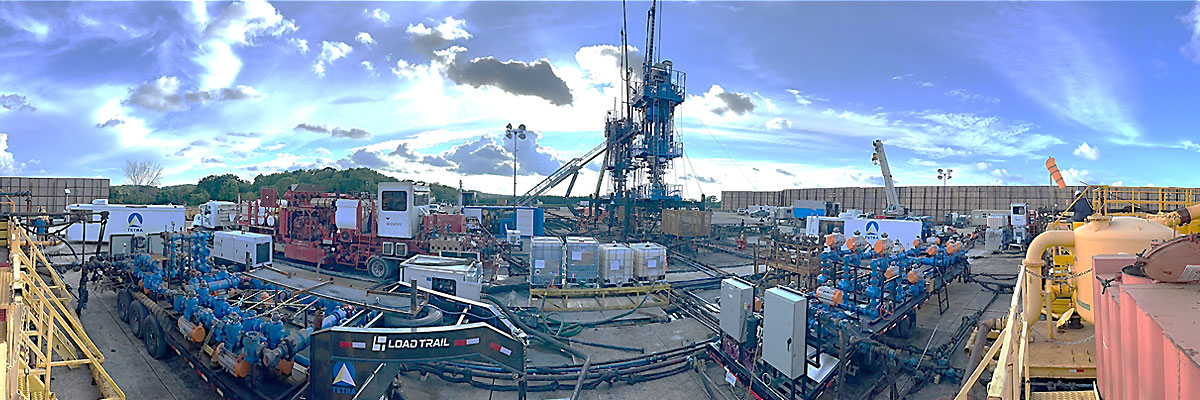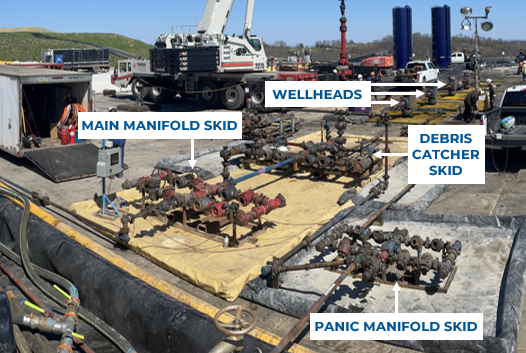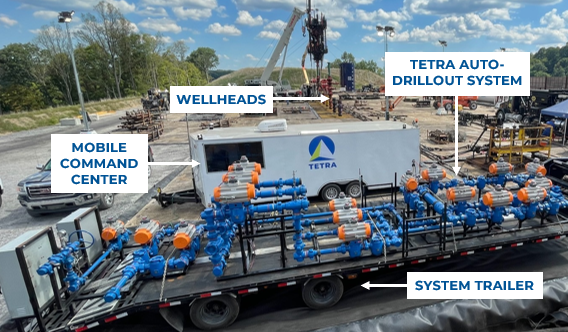Tehokkaampi tapa tulppajätteen puhdistukseen
Bram Alackness | Tuotantolinjan päällikkö | 14. maaliskuuta 2025

Kaivon tulppien ja murtohiekan puhdistaminen voi olla sotkuista ja aiheuttaa huomattavia riskejä työntekijöiden turvallisuudelle, tuotannolle sekä ympäristölle. Tyypillisessä vaakasuorassa porausreiässä, jossa käytetään perinteistä plug-and-perf-menetelmää, asetetaan useita välitulppia eri sivuhaaroihin vaiheiden eristämiseksi. Kun hydraulinen murtoprosessi on saatu päätökseen, porausreikään asetetut tulpat porataan tyypillisesti pois joko kierreputkiyksikön tai hydraulisen viimeistely-yksikön avulla. Tulppien poistaminen mahdollistaa vapaan virtausreitin hiilivedyille muodostumasta porausreikään ja sitä kautta pintaan. Porausvaihe edellyttää eri palveluntarjoajien, erityisesti virtauspalveluista vastaavan yrityksen (TETRA) ja porauslaiteyhtiön, tarkkaa yhteistyötä. Porausvaiheen aikana on ylläpidettävä jatkuvaa nesteen kiertoa porausreiässä, jotta tulppajätteet ja murtohiekka saadaan poistettua tehokkaasti. Jos tätä toimenpidettä ei suoriteta asianmukaisesti, porausreikään voi kertyä roskia, mikä voi puolestaan johtaa erilaisiin ongelmiin, kuten putken juuttumiseen tai porausreiän hallinnan menettämiseen.[*]
Perinteinen Puhdistus
Perinteinen porauspaketti koostuu yleensä kolmesta laiteyksiköstä - pääjakeluputkesta, varapaniikkiputkesta (panic manifold) ja roskienkerääjästä - jotka kaikki on siirrettävä paikoilleen trukilla ja liitettävä yhteen korkeapaineisten virtausputkien kanssa. Näiden järjestelmien käyttö ja huolto vaatii vähintäänkin kahden henkilön työpanoksen, joka edellyttää usein venttiilien manuaalista käyttöä ja suodatinseulojen poistamista. Nämä erityistehtävät edellyttävät, että työntekijät astuvat jatkuvasti korkeapainevirtauslinjojen yli ja kurkottelevat niiden ympärillä, paineiden vaihdellessa välillä 1 000-3 000 PSI. Manuaalinen prosessi ei ainoastaan altista työntekijöitä mahdolliselle paineenpurkautumiselle, vaan se lisää myöskin vuotojen riskiä, jotka voivat vahingoittaa lähiympäristöä ja myös pysäyttää toiminnan kokonaan.

Automaattinen Puhdistus
TETRA tunnisti perinteisten järjestelmien vaarat ja riskit, ja päätti kehittää alan ensimmäisen automaattisen porausjärjestelmän. Kyseessä on vallankumouksellinen kokonaisratkaisu, jossa kaikki tarvittavat komponentit on sijoitettu yhdelle 8 x 40 jalan perävaunuun asennettavalle telineelle, joka huuhtelee automaattisesti tulpat ja hiekan pois porausoperaation aikana.
TETRA Auto-Drillout -järjestelmä on suunniteltu hallitsemaan porausreiän painetta entistä tehokkaammin ja parantamaan turvallisuutta.Se vähentää merkittävästi loukkaantumisriskiä, sillä se minimoi kenttähenkilöstön tarpeen suorittaa manuaalisia toimenpiteitä, kuten venttiilien kääntämistä ja roskasuodattimien irrotusta sekä vaihtoa. Järjestelmää ohjataan liikkuvasta komentokeskuksesta käsin, mikä vähentää myöskin altistumista korkeapaineriskeille ja mahdollisesti loukkuun jääneelle paineelle. Järjestelmän oma huuhteluprosessi estää muodostumasta tulevat painepiikit ja mahdollistaa perusteellisen roskien ja hiekan puhdistuksen. Tämä vähentää työkalujen jumiutumisen ja tuottamattoman ajan (NPT) riskiä merkittävästi.

Helposti kuljetettava ja nopeasti käyttöönotettava yksikkö on rakennettu yhdelle rungolle (single-skid), ja sen kompakti koko sekä vähäinen huoltotarve minimoivat kalliit seisokkiajat. Täysin integroidussa putkistossa on automaattisella huuhtelujaksolla varustettu roskienkerääjä, moniosainen jakotukkijärjestelmä sekä integroitu hätäpaneeli. Kaikki nämä komponentit on yhdistetty ohjelmoitavaan logiikkaohjaimeen (PLC), joka mahdollistaa etävalvonnan ja -ohjauksen. Käyttäjät voivat käyttää ohjauspaneelia mobiililaitteella valvoakseen ja hallitakseen toimintaa – erityisen hyödyllinen ominaisuus, kun säätöjä on tehtävä työskentelyalueen ulkopuolelta käsin. Älykäs järjestelmä tallentaa myös historiatietoja, kuten painetiedot, venttiilien toiminnot, hälytykset ja säiliöiden pinnankorkeudet.
Manuaalinen seulan vetäminen vs. automaattinen huuhtelu
Tavanomaisen pakkauksen seulan puhdistaminen vaatii yleensä vähintään kaksi henkilöä ja noin neljä minuuttia huuhtelukertaa kohti. Manuaaliset vaiheet ovat seuraavat: virtauksen ohjaaminen, piipun eristäminen, paineen poistaminen, seulan poistaminen järjestelmästä, seulan puhdistaminen ja asettaminen takaisin paikalleen sekä virtauksen palauttaminen juuri puhdistettuun linjaan. Manuaalinen toiminta altistaa työntekijät käsi- tai selkävammojen sekä mahdollisen jäännepaineen vaaroille.
Perinteisen porausjärjestelmän jokaisen jakson huoltaminen vaatii vähintäänkin kaksi työntekijää suorittamaan useita manuaalisia vaiheita, jotka kestävät noin neljä minuuttia. Työntekijät altistuvat tällöin käsien tai selän vammoille sekä mahdollisen puristuspaineen aiheuttamille vaaroille.Sen sijaan TETRA Auto-Drillout System -järjestelmän käyttö vaatii vain yhden henkilön, ja se suorittaa jokaisen puhdistussyklin noin 40 sekunnissa. Automaattiset vaiheet ovat:
[1] Anturi havaitsee paine-eron, joka kertoo roskien läsnäolosta.
[2] Virtaus ohjautuu automaattisesti ensisijaisesta linjasta toissijaiseen linjaan.
[3] Päävirtausjohto jakotukin alapuolella sulkeutuu ja ohjaa hetkellisesti virtausta puhdistaakseen roskat keräävän suodattimen.
[4] Kun huuhtelujakso on tullut päätökseen, virtaus palaa automaattisesti toissijaisesta linjasta ensisijaiseen linjaan.
Tapaustutkimus 1: 40 prosentin vähennys Rig-up:ssa
TETRA Auto-Drillout -järjestelmää hyödynnettiin ensimmäisen kerran Appalachian alueella kesällä 2022, jolloin sitä käytettiin 13 epäkonventionaalisessa kaasukaivossa. Neljän kuukauden häiriöttömän käytön aikana yksikkö puhdisti yli 2 300 tulppaa ilman, että yhtään seulaa olisi tarvinnut vetää pois, eikä prosessista syntynyt yhtään tuottamatonta aikaa. Toiminnanharjoittajan kannalta mitattavissa oleva arvo oli se, että järjestelmä vähensi porauslaitteiston ylös- ja alasajoon kuluvaa aikaa 40 prosenttia, riskialtistusta 33 prosenttia sekä järjestelmän osien kulumista 65 prosenttia, mikä puolestaan alensi merkittävästi käyttökustannuksia sekä paransi turvallisuutta.
Tapaustutkimus 2: Yli 15 000 tulppaa on puhdistettu pois käytöstä
Sama toimija otti jälleen TETRA Auto-Drillout -järjestelmän käyttöönsä Appalakkien altaassa. Noin 30 kuukauden aikana järjestelmällä huollettiin 178 porausreikää ja puhdistettiin yhteensä 15 425 tulppaa ilman, että yhtään roskienkeräysseulaa tarvitsi nostaa pintaan puhdistettavaksi. Prosessi ei myöskään aiheuttanut yhtäkään tuotantokatkosta tai HSE-tapahtumaa.
TETRAn järjestelmää käytettiin turvallisesti liikkuvan komentokeskuksen perävaunusta käsin, ja sen avulla poistettiin venttiilien manuaalinen ohjaus ja roskienkeräysseulojen vetäminen. Tehokkuuden osalta se paransi paineenhallintaa porauksen aikana mahdollistaen ennalta ohjelmoidun venttiilien sekvensoinnin ja ylläpitäen tasaiset paineet sekä virtausnopeudet ilman suuria vaihteluita, kun virtausta vaihdeltiin kaksilinjaisen järjestelmän välillä.
Loppujen lopuksi TETRA Auto-Drillout -järjestelmä vähensi merkittävästi tuotannonharjoittajan turvallisuus- ja ympäristöriskejä sekä paikan päällä työskentelevien henkilöiden määrää, mikä toi poikkeuksellista lisäarvoa kaasuporauksen kehittämiseen.
[*] Haithem Trabelsi, et al (2021), "Bridge Plug Drillouts Cleaning Practices: An Overview,” Natural Resources, Vol. 12, No. 2, pp. 19–33, helmikuu 2021.


